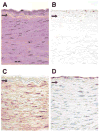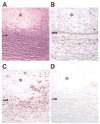Up-regulation of a hydrogen peroxide-responsive pre-mRNA binding protein in atherosclerosis and intimal hyperplasia
- PMID: 18508286
- PMCID: PMC2723736
- DOI: 10.1016/j.carpath.2008.03.008
Up-regulation of a hydrogen peroxide-responsive pre-mRNA binding protein in atherosclerosis and intimal hyperplasia
Abstract
Background: Multiple lines of investigation have implicated hydrogen peroxide (H(2)O(2)) as an important endogenous mediator of cell proliferation in the vessel wall. Heterogeneous nuclear ribonucleoprotein C (hnRNP-C), a nuclear pre-mRNA binding protein that plays roles in vertebrate cell proliferation and differentiation, has been identified as a component of a vascular cell signaling pathway activated by low physiologic levels of H(2)O(2). The expression of hnRNP-C in human arteries has not previously been assessed.
Methods: Segments of human proximal internal carotid arteries were evaluated for the expression of hnRNP-C by immunohistochemistry.
Results: In normal proximal internal carotid arteries, hnRNP-C is expressed predominantly by the endothelium, with significantly lower expression by medial smooth muscle. In preatherosclerotic intimal hyperplasia, hnRNP-C is up-regulated in the artery wall, due to the robust expression by the intimal smooth muscle cells, without up-regulation in the medial smooth muscle cells. In arteries with atherosclerotic lesions, there is strong expression of hnRNP-C not only by intimal cells but also by medial smooth muscle cells.
Conclusions: The H(2)O(2) responsive pre-mRNA binding protein hnRNP-C is up-regulated in atherosclerosis and in preatherosclerotic intimal hyperplasia in humans, supporting the hypothesis that H(2)O(2) is a regulator of vascular cell proliferation in these conditions. These data also suggest that hnRNP-C may be useful as a marker of vascular cell activation.
Figures





Similar articles
-
Protein kinase CK1alphaLS promotes vascular cell proliferation and intimal hyperplasia.Am J Pathol. 2010 Sep;177(3):1562-72. doi: 10.2353/ajpath.2010.100327. Epub 2010 Aug 9. Am J Pathol. 2010. PMID: 20696773 Free PMC article.
-
Altered vascular activation due to deficiency of the NADPH oxidase component p22phox.Cardiovasc Pathol. 2014 Jan-Feb;23(1):35-42. doi: 10.1016/j.carpath.2013.08.003. Epub 2013 Sep 12. Cardiovasc Pathol. 2014. PMID: 24035466
-
Bolus endovascular PDGFR-beta antisense treatment suppressed intimal hyperplasia in a rat carotid injury model.Circulation. 2000 Sep 12;102(11):1330-6. doi: 10.1161/01.cir.102.11.1330. Circulation. 2000. PMID: 10982551
-
Hemodynamic parameters and early intimal thickening in branching blood vessels.Crit Rev Biomed Eng. 2001;29(1):1-64. doi: 10.1615/critrevbiomedeng.v29.i1.10. Crit Rev Biomed Eng. 2001. PMID: 11321642 Review.
-
Correlation between carotid intimal/medial thickness and atherosclerosis: a point of view from pathology.Arterioscler Thromb Vasc Biol. 2010 Feb;30(2):177-81. doi: 10.1161/ATVBAHA.108.173609. Epub 2009 Aug 13. Arterioscler Thromb Vasc Biol. 2010. PMID: 19679833 Review.
Cited by
-
HuR regulates alternative splicing of the TRA2β gene in human colon cancer cells under oxidative stress.Mol Cell Biol. 2014 Aug;34(15):2857-73. doi: 10.1128/MCB.00333-14. Epub 2014 May 27. Mol Cell Biol. 2014. PMID: 24865968 Free PMC article.
-
PPARγ Inhibits VSMC Proliferation and Migration via Attenuating Oxidative Stress through Upregulating UCP2.PLoS One. 2016 May 4;11(5):e0154720. doi: 10.1371/journal.pone.0154720. eCollection 2016. PLoS One. 2016. PMID: 27144886 Free PMC article.
-
Proteomics Studies Suggest That Nitric Oxide Donor Furoxans Inhibit In Vitro Vascular Smooth Muscle Cell Proliferation by Nitric Oxide-Independent Mechanisms.Molecules. 2023 Jul 28;28(15):5724. doi: 10.3390/molecules28155724. Molecules. 2023. PMID: 37570694 Free PMC article.
-
Hydrogen peroxide alters splicing of soluble guanylyl cyclase and selectively modulates expression of splicing regulators in human cancer cells.PLoS One. 2012;7(7):e41099. doi: 10.1371/journal.pone.0041099. Epub 2012 Jul 20. PLoS One. 2012. PMID: 22911749 Free PMC article.
-
Protein kinase CK1alphaLS promotes vascular cell proliferation and intimal hyperplasia.Am J Pathol. 2010 Sep;177(3):1562-72. doi: 10.2353/ajpath.2010.100327. Epub 2010 Aug 9. Am J Pathol. 2010. PMID: 20696773 Free PMC article.
References
-
- Szocs K, Lassegue B, Sorescu D, Hilenski LL, Valppu L, Couse TL, Wilcox JN, Quinn MT, Lambeth JD, Griendling KK. Upregulation of Nox-based NAD(P)H oxidases in restenosis after carotid injury. Arterioscler Thromb Vasc Biol. 2002;22:21–7. - PubMed
-
- Jacobson GM, Dourron HM, Liu J, Carretero OA, Reddy DJ, Andrzejewski T, Pango PJ. Novel NAD(P)H oxidase inhibitor suppresses angioplasty-induced superoxide and neointimal hyperplasia of rat carotid artery. Circ Res. 2003;92:637–43. - PubMed
-
- Stone JR, Collins T. The role of hydrogen peroxide in endothelial proliferative responses. Endothelium. 2002;9:231–8. - PubMed
-
- Lambeth JD. NOX enzymes and the biology of reactive oxygen. Nat Rev Immunol. 2004;4:181–9. - PubMed
Publication types
MeSH terms
Substances
Grants and funding
LinkOut - more resources
Full Text Sources
Medical

